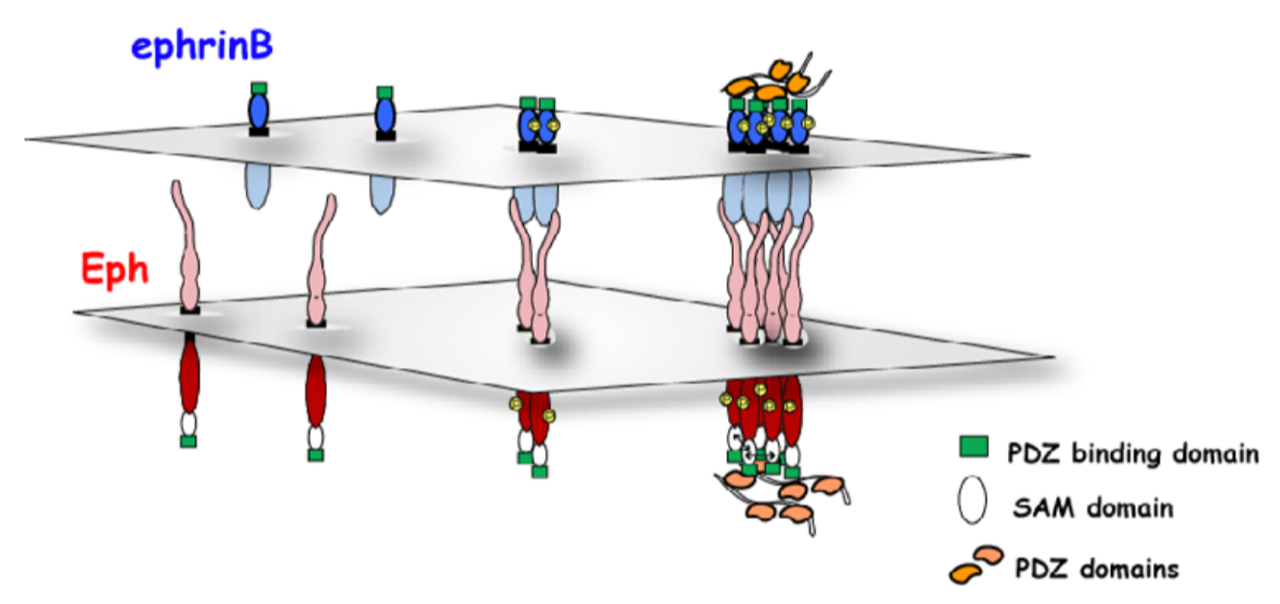Project 07
Dynamics of membrane receptor clustering in endothelial cells
Principle Investigator: Prof. Dr. Amparo Acker-Palmer
Research Areas: Molecular and Cellular Neurobiology

Summary
The spatial organization of transmembrane receptors is a critical step in propagation of signals and receptor trafficking in cells. The largest subfamily of receptor tyrosine kinases (RTK), Eph receptors (Ephs) and their ligands ephrins, are a prototypical example of membrane signaling hubs organized by homotypic multimeric clustering. Moreover, we have shown that the ephrinB ligands emerge as nucleation seeds controlling the clustering, trafficking, and ultimately function of many other receptors at the membrane involving homotypic Ephrin clusters and heterotypic complexes at the cell membrane. Here, we will specifically characterize using super-resolution microscopy the dynamic spatial arrangement of the different components of such homotypic and heterotypic complexes. We will also investigate how these arrangements are regulated at the membrane, recruiting cytosolic adaptors to achieve a variety of efficient functional outcomes. In particular, we will study these complexes in endothelial cells since the signaling derived from these molecular interactions has a functional role in angiogenesis and blood-brain barrier formation.

Prof. Dr. Amparo Acker-Palmer
Steering Board of the CRC 1507
Institute of Cell Biology and Neuroscience
Goethe University, Frankfurt
P07: PROJECT-RELATED PUBLICATIONS
- Bissen D, Kracht MK, Foss F, Hoffmann J, Acker-Palmer A (2021) EphrinB2 activation stabilizes mushroom spines during denervation-induced homeostatic plasticity. Cell Reports 34: e108923.
- Harde E, Nicholson L, Furones-Cuadrado B, Bissen D, Wigge S, Urban S, Segarra M, Ruiz de Almodovar C, Acker-Palmer A (2019) EphrinB2 regulates VEGFR2 during dendritogenesis and hippocampal circuitry development. eLife 8: e49819.
- Segarra M, Aburto MR, Hefendehl J, Acker-Palmer A (2019) Neurovascular interactions in the nervous system. Annu Rev Cell Dev Biol 35: 615-35.
- Segarra M, Aburto MR, Cop F, Llaó-Cid C, Härtl R, Damm M, Bethani I, Parrilla M, Husainie D, Schänzer A, Schlierbach H, Acker T, Mohr L, Torres-Masjoan L, Ritter M, Acker-Palmer A (2018) Endothelial Dab1 signaling orchestrates neuro-glia-vessel communication in the central nervous system. Science 361: 6404.
- Pfennig S, Foss F, Bissen D, Harde E, Treeck JC, Segarra M, Acker-Palmer A (2017) GRIP1 binds to ApoER2 and EphrinB2 to induce activity-dependent AMPA receptor insertion at the synapse. Cell Rep 21: 84-96.
- Geiger JC, Lipka J, Segura I, Hoyer S, Schlager MA, Wulf PS, Weinges S, Demmers J, Hoogenraad CC, Acker-Palmer A (2014) The GRIP1/14-3-3 pathway coordinates cargo trafficking and dendrite development. Dev Cell 28: 381-93.
- Senturk A, Pfennig S, Weiss A, Burk K, Acker-Palmer A (2011) EphrinBs are essential components of the Reelin pathway to regulate neuronal migration. Nature 472: 356-60; 478: 274.
- Sawamiphak S, Seidel S, Essmann CL, Wilkinson G, Pitulescu ME, Acker T, Acker-Palmer A (2010a) Ephrin-B2 regulates VEGFR2 function in developmental and tumour angiogenesis. Nature 465: 487-91.
- Essmann CL, Martinez E, Geiger J, Zimmer M, Traut M, Stein V, Klein R, Acker-Palmer A (2008) Serine phosphorylation of ephrinB2 regulates trafficking of synaptic AMPA receptors. Nat Neurosci 11: 1035-43.
- Segura I, Eβmann CL, Weinges S, Acker-Palmer A (2007) Grb4 and GIT1 transduce ephrinB reverse signals modulating spine morphogenesis and synapse formation. Nat Neurosci 10: 301-10.
